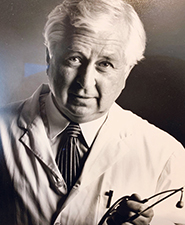Dr Dennis Myron Karpiak, 1943–2019

Dr Dennis Karpiak passed away in the ICU of Royal Inland Hospital in Kamloops, BC, on 23 February 2019 at the age of 75. It was ironic, but perhaps fitting, that he would pass away in the hospital where he had practised critical care medicine, respirology, and general internal medicine for over 30 years.
Dennis was born in Dauphin, Manitoba, but grew up in Oshawa, Ontario. As a high school graduate he distinguished himself academically, receiving an Ontario Scholar award. It was probably in Oshawa where he also developed his of love of cars. While in university he had summer employment at the GM plant. He bought his first Corvette while in university, and took a course in high-speed driving at Ontario’s Motorsport racetrack. During his last week in hospital I found him reading the latest Road and Track magazine. One of his projects, in his last few years, was restoring a 1965 Corvette convertible, which won the Best of the Best award at a classic car show in Kamloops.
Dennis completed his undergrad and medical school at the University of Toronto, graduating in 1968. He completed his internship and 2 years of general internal medicine at St. Paul’s Hospital in Vancouver (1969–1971) followed by 3 years of subspecialty training in critical care and respiratory medicine at the University of Alberta in Edmonton. Upon completion of his training, he was recruited by Royal Inland Hospital to head the cardiopulmonary department.
Over the years Dennis was a fierce advocate for Kamloops. He was instrumental in the establishment of a respiratory technology program at Thompson Rivers University, which continues to supply respiratory therapists to all regions of the province. In recent years he was an active participant in the successful opposition to an open-pit mine on the outskirts of Kamloops.
Dennis was well regarded for his professionalism, and served several terms as a then BCMA Board member for the Kamloops area. He was known for his ready availability and willingness in taking on the care of seriously ill patients. This availability was most appreciated by those referring physicians in surrounding smaller communities. He could be counted on to take charge in a crisis, even in nonmedical situations. Several years ago, at Sun Peaks, a young girl ended up hanging some 25 feet above the ground while mounting a chairlift. Dennis immediately placed himself below the chair in order to break her fall. He suffered a neck injury, which eventually resulted in cervical fusion surgery. He received the Governor General’s Medal of Bravery for his prompt response to this emergency.
Dennis seemed to welcome controversy, often taking a contrary point of view, which he could expertly articulate. He loved travel, family, gardening, cars, deep-sea fishing, and telling humorous stories of his experiences (most of which may have had some basis in fact). His dislikes included technology (unless it pertained to cars), doctors making rounds in bicycle shorts, golf, and photo radar. He freely shared his views on these topics. His political viewpoint was definitely to the right of centre.
Dennis leaves behind his wife of 48 years, Robin; his sons Scott and Andrew; their spouses Rebecca and Cassandra; and four grandchildren. Dennis was a larger-than-life presence, both in his professional and personal life, and he will be missed.
—Glenn A. Scheske, MD, FRCPC
